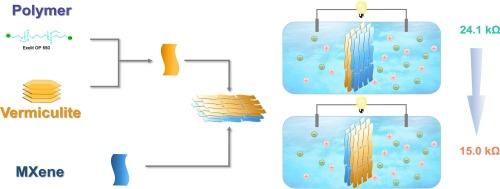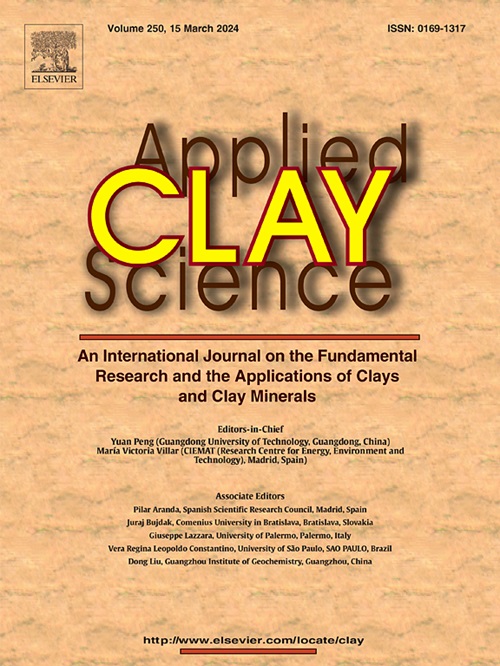Different hydrophilic bilayer membranes for efficient osmotic energy harvesting with high-concentration exfoliation
IF 5.3
2区 地球科学
Q2 CHEMISTRY, PHYSICAL
引用次数: 0
Abstract
Sustainable, clean, seawater-river interface osmotic energy shows great potential in replacing traditional fossil fuel sources. Two-dimensional (2D) nanofluidic channels, known for their high throughput, high integration density, and excellent scalability, render practical applications feasible for osmotic energy harvesting. However, 2D nanofluidic channels face challenges such as high internal resistance and high costs, which keep the ultimate goal of large-scale osmotic energy harvesting distant. Herein, a novel method to regulate ion transport resistance by constructing different hydrophilic asymmetric nanofluidic channels using bilayer membrane of vermiculite and MXene is proposed. Vermiculite nanosheets are prepared via polymer-assisted exfoliation method utilizing polyethyl-phosphate glycol ester. After simple stirring and maturation process, the exfoliation concentration can reach 20 phr within 8 h, which is 20 times higher than the previously reported maximum. The internal resistance of the bilayer membrane decreased from 24.1 kΩ to 15.0 kΩ as the direction of ions transport changes. Oxygen plasma assistance enabled the bilayer membrane to reach a maximum power density of 4.66 W m−2. The high-efficiency preparation method of vermiculite nanosheets and the emphasis on membrane surface properties offer new insights into practical osmotic energy harvesting.

通过高浓度剥离实现高效渗透能量采集的不同亲水双层膜
可持续、清洁、海水-河流界面渗透能在替代传统化石燃料来源方面显示出巨大潜力。二维(2D)纳米流体通道以其高通量、高集成度和出色的可扩展性而著称,为渗透能收集的实际应用提供了可行性。然而,二维纳米流体通道面临着高内阻和高成本等挑战,这使得大规模渗透能量收集的最终目标遥遥无期。本文提出了一种利用蛭石和MXene双层膜构建不同亲水性非对称纳米流体通道来调节离子传输阻力的新方法。蛭石纳米片是利用聚乙基磷酸乙二醇酯通过聚合物辅助剥离法制备的。经过简单的搅拌和熟化过程,剥离浓度可在 8 小时内达到 20 phr,比之前报道的最大值高出 20 倍。随着离子传输方向的改变,双层膜的内阻从 24.1 kΩ 降至 15.0 kΩ。氧等离子体的辅助作用使双层膜达到了 4.66 W m-2 的最大功率密度。蛭石纳米片的高效制备方法和对膜表面特性的重视为实用渗透能量收集提供了新的见解。
本文章由计算机程序翻译,如有差异,请以英文原文为准。
求助全文
约1分钟内获得全文
求助全文
来源期刊

Applied Clay Science
地学-矿物学
CiteScore
10.30
自引率
10.70%
发文量
289
审稿时长
39 days
期刊介绍:
Applied Clay Science aims to be an international journal attracting high quality scientific papers on clays and clay minerals, including research papers, reviews, and technical notes. The journal covers typical subjects of Fundamental and Applied Clay Science such as:
• Synthesis and purification
• Structural, crystallographic and mineralogical properties of clays and clay minerals
• Thermal properties of clays and clay minerals
• Physico-chemical properties including i) surface and interface properties; ii) thermodynamic properties; iii) mechanical properties
• Interaction with water, with polar and apolar molecules
• Colloidal properties and rheology
• Adsorption, Intercalation, Ionic exchange
• Genesis and deposits of clay minerals
• Geology and geochemistry of clays
• Modification of clays and clay minerals properties by thermal and physical treatments
• Modification by chemical treatments with organic and inorganic molecules(organoclays, pillared clays)
• Modification by biological microorganisms. etc...
文献相关原料
公司名称
产品信息
阿拉丁
Sodium hydroxide (NaOH)
阿拉丁
Potassium hydroxide (KOH)
阿拉丁
Potassium chloride (KCl)
阿拉丁
Sodium chloride (NaCl)
 求助内容:
求助内容: 应助结果提醒方式:
应助结果提醒方式:


